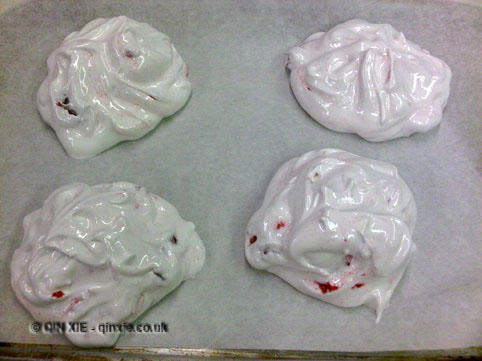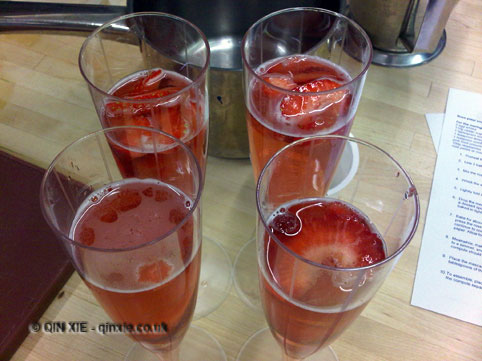- Tragic moment Chinese pensioner drowns in ankle-deep flood water after falling off his scooter because passers-by refused to save him for THREE MINUTES
- Bee careful up there! China’s incredible vertical apiary where over 700 hives hang from 4,000 foot high cliff-face
- It’s too hard to say goodbye! Teary-eyed toddlers sob their way through day one of school as they learn to let their parents go for the very first time
- Riding the dragon: Chinese company builds ridiculously lavish car inspired by the mystical creature using 30,000 yak bones and 1,999 pieces of solid gold
Category Archives: Foodepedia
Catch at Andaz Hotel
Published on Foodepedia on 24th October 2011:
40 Liverpool Street, City of London EC2M 7QN www.andazdining.com
17th October marked the final night of the 2011 London Restaurant Festival, celebrated with an awards ceremony at Old Spitalfield’s Market.
Having dined out almost religiously for two solid weeks, it seemed wildly appropriate for our feasting to end with seeing Hedone’s Mikael Jonsson picking up an award for bravery as the first gong of the evening. Wildly, mostly because Jonsson and his partner had been attacked at the restaurant just a few days earlier but still returned for service the following day with fierce determination.
But on this night, only a short stop could be afforded before it was time to put down the Colchester rocks and chilled Laurent Perrier and head across the road to Andaz Hotel. Because while the feasting of London Restaurant Festival was almost done, mine of that evening was just beginning – an odyssey of fruits de mer awaited my friend and I at Catch, the seafood and fish restaurant of Andaz Hotel.
After attending the Aldeburgh Food and Drink Festival Conference last month, I was particularly taken by Catch’s proudly sustainable approach to seafood. Certainly, it would be even better if their environmental considerations were matched by well prepared dishes.
As we were seated, water and champagne were offered alongside an amuse bouche of pea velouté with cod. Declining the champagne in favour of a fragrant Gavi, we happily indulged our appetites with the intense smoothness of the velouté.
Despite hearing rumours that the Andaz team were out in force at the LRF Awards, it was reassuring to be informed that the head chef, Martin Scholz, was actually holding fort in the kitchen. It was also probably reassuring for my gilded friend to find that while it’s not the done thing for bankers to be out on a Monday night, the lighting was dim enough and the environs private enough to ensure some anonymity. Indeed, for this EC2 restaurant, diners on a Monday appear to be mostly guests at the hotel rather than City professionals.
I was rather tempted by the memory of delicately sweet Kumamotos, which rather unusually comes in fours or eights rather than a dozen or half; but having just slipped oysters moments earlier, I opted instead to open with a beef tartare adorned by Sevruga caviar. Seared Scottish scallops, richly furnished with chorizo and truffle, served the banker well as the other starter.
The generously portioned mains, while not as opulent as the starters, were equally rich. Cornish monkfish cheeks, Shetland mussels, Brittany clams sitting above a caramelised fennel risotto would offer a sumptuous feed for the heartiest appetites but after the starters, it proved to be more of a challenge for me. The banker, meanwhile, made his way happily through the Anglesey sea bass and pork belly whilst telling me how he liked the little hooks on the menus.
The desserts offered further nuggets of luxury with lavender marshmallows embellishing champagne peaches in one and mint mojito foam accompanying a lemon tart in the other. But then again, would you expect anything less at a five-star hotel?
As we supped on the last of the Gavi with the post-dessert almond madeleines, it suddenly occurred to us that perhaps three courses was a little too sumptuous on this occasion. For a lover of oceanic offerings, this would have been seafood heaven. For the occasional dabblers, the meats interspersed with the fish allowed for some brief break from pure seafood gluttony. For us, the fantastic service and fabulous food needed stomachs that weren’t already lined with champagne and huîtres.
A shucking good time at Patara
Published on Foodepedia on 8th October 2011:
In this 25th year of my life, I seem to have slipped more oysters than any other. They’ve come from as far as Japan and as close as, well, down the road from where I sat sampling them. And while it has been an experience navigating the subtle shapes, tastes, scents and textures, I’ve never had an opportunity to shuck an oyster myself.
But with the start of the native oyster season came a most irresistible invitation – an evening of champagne and oysters to celebrate these delicate little molluscs.
The event was held at Patara, a Thai restaurant who are putting Maldon oysters on the menu across all their venues for the next two months. Richard Emans, the director of Maldon Oyster Company, was on hand to demonstrate the art of shucking an oyster while we supped on finely chilled champagne and attempted to garner some skills.
It seems that with all the fancy shucking equipment out there, all you really need is a tea towel and a good shucking knife. And the right technique of course.
So to shuck an oyster, start at its hinge. Brace your oyster in the tea towel, flat side up and revealing only the hinge, to protect your hands from potential slipping of the knife. Tackle the crevice in the hinge with your shucking knife at 90º. You want to prise it open with gentle annoyance rather than brute force. Of course that is not to say that some strength is not required too. After all, my first oyster proved to be rather stubborn.
When you do breach its shell, the shucking knife slips subtly inside and you will need to run it along the top shell at 15º. This removes the flesh from the “lid” and allows the two shells to be separated.
The last thing to do is to run along the edges of the flesh and gently flip it in its “cup”, taking care not to lose any of the liquid, so it presents beautifully.
After the demonstration, it was time for the oyster shucking competition. Teamed up with Luiz Hara of thelondonfoodie, we were given two oysters each to practice our technique before being let loose on a pair of sixes per team.
As I struggled through the four oysters I managed to release from captivity, Luiz breezed through the other eight. But unfortunately it wasn’t to the speed of the team placed just across from us, who were indisputably the fastest. Luckily for us, the competition was judged on presentation as well as speed and we knew a thing or two about showing off our wares. Thus coming second on speed wasn’t too detrimental to our efforts.
In the end it came to a harmonious draw. The winning team each slinked off into the night with a proud box of huîtres under arm and a Patara cookbook to remember the evening – but not before being sumptuously fed on oysters and fine Thai cuisine, accompanied by more champagne and wine.
Is matcha the new superfood trend?
Published on Foodepedia on 21st August 2011:
I was recently invited to sample some matcha flavoured frozen yoghurt by the owners of Lalani & Co, a major importer of the Japanese green tea powder. It was introduced to me as the latest superfood trend to sweep the UK because it contains more antioxidants than regular green tea, is low in caffeine and also contains vitamins and minerals.
The truth is, I already knew about the frozen yoghurt and had seen matcha being sold at food festivals as far back as five years ago, and at specialist shops for even longer. But I wanted to learn more about the process of producing matcha from its importers: how it’s transformed from the tea leaves to the green powder form that it’s sold in and of course the traditional Japanese tea ceremony during which it is served.
Well, I learnt that the process is long and intricate with an output rate of just 30g of tea an hour. The high grade tea leaves are grown under the shade in order to concentrate the chlorophyll and amino acids in the leaves. The best leaves are then picked, de-veined and stone-milled between two granite slabs to produce the fine green powder. Because of the friction in the milling process, the production must be extremely slow in order to prevent the powder from burning.
Traditionally, matcha is consumed as part of a long Japanese tea ceremony where hot water is whisked into the green tea powder using a bamboo brush. These days in the UK, it is readily available from specialist tea retailers in its powdered form for you to try at home. I was surprised to learn that my favourite coffee merchants, H.R. Higgins, have started stocking them too.
In fact, it’s widely available in drinks such as lattes and smoothies on the high street but is also often used to flavour iced desserts and chocolate. The likes of Modern Pantry and Bougie Macaron are using matcha in scones, meringues and macarons. It has even appeared as an ingredient on this year’s MasterChef.
While popularity of matcha has certainly grown considerably over the past few years, perhaps with the exception of drinks, its use has been primarily for flavour rather than its health benefits. But with matcha used as an ingredient in confectionery, the resulting product may not be healthy at all. In fact, any health benefits could be cancelled out altogether by other unhealthy ingredients.
So the question is, is matcha the new superfood trend or should we just recognise it as an “exotic new flavour”?
Summer puddings workshop at Leiths
Published on Foodepedia on 22nd June 2011:
The frequent interval of rain and shine over the last couple of months has been fostering in me a sense of perpetual spring. The smallest hints of summer are constantly and rapidly snatched away by morose clouds bearing melancholic rain. There’s no denying that we are in the month of June, but those thundery showers have certainly put a dampener on things.
The unpredictable weather hasn’t stopped Leiths from putting on a summer puddings workshop though, and for a sweet tooth like mine, the offer to attend was never going to be met with much resistance. So there I was on a surprisingly sunny Saturday morning, a large collection of Tupperware in tow, arriving to attend the workshop led by Maxine Clark.
Maxine, or Max as she likes to be called, is the co-author of the Leiths Meat Bible. She’s been with the school for some 20 years but still oozes with enthusiasm. In fact, she says that she can lead an entire workshop just on jelly combinations and given the number of ideas she freely disseminates in the space of five minutes, you can believe her too.
After gathering in the library with coffee and pastries, Max introduces the workshop menu to the group in the airy teaching kitchen. It’s a trio of desserts we were making: rose petal and raspberry meringues with raspberry compote and framboise mascarpone, sparkling Champagne and strawberry jellies with elderflower cream and cherry tartlets with Black Forest sauce. I want to say berry good but that will probably raise a few groans.
 The dessert selection doesn’t read like much work but when Max starts talking about the methodology and the techniques involved, it begins to feel a little daunting. The meringues in particular appear to be laden with a multitude of sins that seem daunting even for someone who enjoys making lemon meringue pies by hand. There’s lots of things that I had never considered like if you start whisking the egg whites and then leave them, they will never turn into meringues when you come back. Or if you over-whisk your eggs white, the meringues will similarly fail.
The dessert selection doesn’t read like much work but when Max starts talking about the methodology and the techniques involved, it begins to feel a little daunting. The meringues in particular appear to be laden with a multitude of sins that seem daunting even for someone who enjoys making lemon meringue pies by hand. There’s lots of things that I had never considered like if you start whisking the egg whites and then leave them, they will never turn into meringues when you come back. Or if you over-whisk your eggs white, the meringues will similarly fail.
And despite it being just three desserts, when you consider the sauces and creams as accompaniments, there seems to be a million steps between the raw ingredients and the finished products. It’s reassuring to be given a schedule to follow as well as the recipes, and that’s all part of the hand holding at a Leiths’ course. We do have a little luxury though – all the ingredients had been weighed out for us ahead of the class and there’s no washing up afterwards.
 Even though it’s not the first dessert on the list, we start with soaking the gelatine leaves so that the champagne and strawberry jelly has time to set. Then over the course of the workshop we whisk through the meringues and roll over the pastry shells until, at last, there’s the final frenzy of whipping and stirring to finish all the accompanying sauces and creams. Generous glasses of dessert wine are poured as we put the finishing touches to the desserts.
Even though it’s not the first dessert on the list, we start with soaking the gelatine leaves so that the champagne and strawberry jelly has time to set. Then over the course of the workshop we whisk through the meringues and roll over the pastry shells until, at last, there’s the final frenzy of whipping and stirring to finish all the accompanying sauces and creams. Generous glasses of dessert wine are poured as we put the finishing touches to the desserts.
The only way of describing the end of the course is a satisfying relief – when everything comes together and there’s nothing more to do but enjoy. Well, aside from meticulously packing everything up in assorted Tupperware and carrying the whole load home.
For a full list of Leiths courses, visit their website at www.leiths.com
